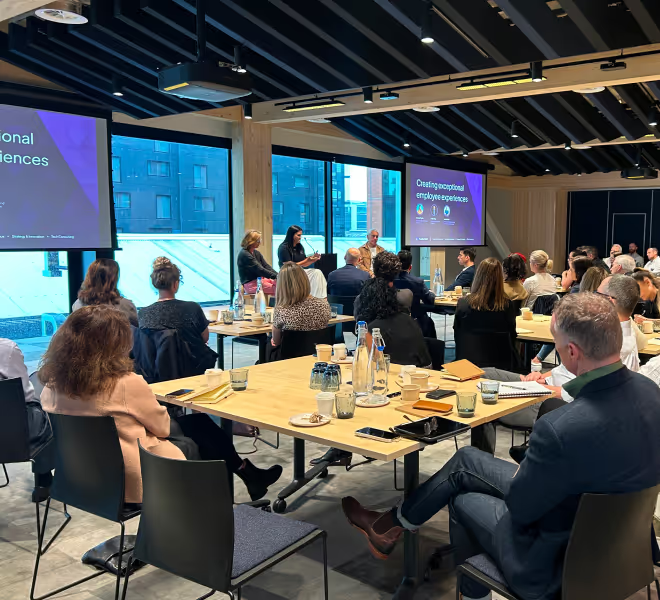When I first started at Purple Shirt just shy of a year ago, I sat down for a coffee chat with each of the team to find out what made each of them tick. After a period of reflection, I was struck by how motivated our people are to take responsibility to build and strengthen healthy relationships within our own team and with our clients. As the new custodian of development for our people, I identified the opportunity to leverage our current culture and inject learning as a core value. Ultimately the intention was to use our culture to underpin our employee development and drive performance.
This article will explain how we used our culture at Purple Shirt to underpin the creation of a sustainable employee development framework, and how prescribing meaning has helped the goals become attainable.
Defining what professional development and maturity should look like for UX Designers is not easy
We’re designers, we’re steeped in ambiguity and we are used to navigating uncharted waters.
In the same way we approach our work, we needed to define a framework that would help advance our performance. Part of the challenge upfront was establishing what competencies and skills we should measure against (KPIs) and how each individual's development plan should help them achieve this.
Coming from a teaching and coaching background this should have been relatively straightforward to create, but something was jarring for me. Performance and development need to be centered around relationships and a two-way street to create value, not a top-down metric driven approach.
We knew what we didn’t want to do
After talking this through with Jon Martin, our Head of Design, we put some principles in place to ensure we didn’t default to traditional solutions such as:
- KPIs that do not directly connect to the person’s job or the larger organisational vision and add complexity beyond the existing skill sets
- A likert scale metrics approach. If someone's put in a position to feel like they’re not achieving, they are not going to feel motivated to develop in these areas. You’ve got bigger leadership issues at play if this is the case!
- Bolt on yearly conferences/training in isolation to an employee development plan.
Defining what we didn’t want to do helped us get clarity on the approach we needed to take.
Purple Shirt’s competency based approach
With a conversation-driven philosophy to development, we created a competency based framework where individuals rate their ‘confidence level’ for each stage of our design methodology which broadly reflects how we work.
The game changer to this approach is the confidence indicators that help stimulate the conversation between the manager and team member to then agree on the current rating for each competency. The agreed indicators then inform the individuals development plan, wherein we create a plan around the areas they feel less confident in.
We then established a rhythm of weekly reflections, quarterly check-ins, and annual reviews and it appears that this framework is working for us. What has caught me by surprise is the team’s enthusiastic response to the importance we’ve placed on tracking the significance of an individual's personal contribution and the way in which they do this (culture). We do this through regular reflections and conversations on the meaning behind their output. Having performance based specific goals means they’re competing against their previous performance as opposed to competing with someone else.
Flexibility and sustainability are key
We’ve built flexibility into our employee development strategy, so that changes can be made to an individual’s plan at any time. It’s a sustainable practice, as in set and reset, not set and forget.
To help us set and reset, we’ve recently been fortunate to be part of the Make Meaningful Work global pilot which is a platform that helps people add value to their work using tools as a catalyst to find hidden value and make it more visible. We’ve started using some of these tools at Purple Shirt to help reflect, adapt, and support our people to create a growth mindset to progress. This aligns to our development approach and could eventually become our key performance tool.
Learning through practice
This year we’ve been asked by other organisations to provide skills based training to help upskill their UX Teams. Whilst training on essential UX skills and practices is helpful, it shouldn’t be delivered in isolation. Neuroplasticity suggests that humans can rewire the brain by creating habits. Repetition creates neural pathways that serve as the foundation of our habits and mindsets. When it comes to training, it's critical that we move what we've learned from our short-term memory and embed it into our longer-term memory, using frequent behaviours.
For this reason, the training we deliver has a practical focus that establishes foundational practices to apply these learnt skills and develop a peer feedback cycle. This supports people to be vulnerable, and helps keep everyone accountable and moving forward together.
In summary
Having a sense of meaning implies continuous learning. If this is to be supported by foundational trust and safety then leaders must not only enable the space for their people to have deeper reflections – it’s important they are doing the same for themselves.
"Good leaders make people feel that they’re at the very heart of things, not at the periphery. Everyone feels that he or she makes a difference to the success of the organization. When that happens people feel centered and that gives their work meaning.”—Warren G. Bennis
We’re only at the start of our employee development journey but have already seen increased engagement in our people.
- They have a greater connection to Purple Shirt’s vision and values
- Regular conversations about the meaning in their work are occurring (not just the transactional output)
- Increased self-awareness – knowing their strengths and what they have to learn
- Cultivating their own creativity and value – removing comparisons to others
- Practice deep dives with peers and clients to support continuous reflection and leadership
- Converting sensemaking into real and practical outcomes.
Get in touch if you want to learn more about our approach or if you’re interested in learning more about Make Meaningful Work.






